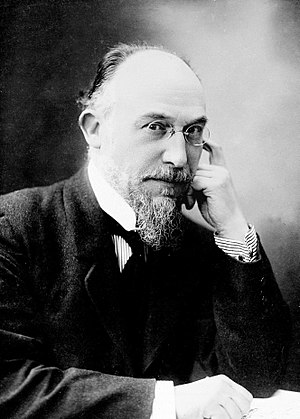Erik Satie: Difference between revisions
(Created page with "==Relevance== {{Page |DiscogsArtistId=95539 |WikipediaPageTitle=Erik_Satie }} Category:Influences on Morrissey - Music") |
No edit summary |
||
| Line 7: | Line 7: | ||
[[Category:Influences on Morrissey - Music]] | [[Category:Influences on Morrissey - Music]] | ||
[[Category:Songs used in pre-show]] | |||
Revision as of 03:25, 28 November 2021
Relevance
Mentioned In
Discogs Information
Profile
Born: May 17, 1866 (Honfleur, France). Died: July 1, 1925 (Arcueil, France).
Erik Satie, was a French composer and pianist. A colourful figure in the early 20th century Parisian avant-garde, he referred to himself as a "phonometrograph" or "phonometrician" (meaning "someone who measures (and writes down) sounds"), preferring this designation to that of "musician," after having been called "a clumsy but subtle technician" in a book on contemporary French composers published in 1911. Later, from the 1940s on, predominantly John Cage presented Satie's work as that of an inventor of a new and modern musical expression, and so he was slowly rediscovered and became a precursor to artistic movements such as minimalism, repetitive music, ambient (called "Furniture Music" by Satie) and the Theatre of the Absurd. In addition to his body of music, Satie also left a remarkable set of often humorous and witty writings.
External Links
- https://www.discogs.com/artist/95539-Erik-Satie
- https://www.erik-satie.com/
- https://www.facebook.com/eriksatiesite/
- https://en.wikipedia.org/wiki/Erik_Satie
- https://www.imdb.com/name/nm0006273/
- https://www.britannica.com/biography/Erik-Satie
- https://adp.library.ucsb.edu/index.php/mastertalent/detail/102611/Satie_Erik
Wikipedia Information
 |
Eric Alfred Leslie Satie (17 May 1866 – 1 July 1925), who signed his name Erik Satie after 1884, was a French composer and pianist. He was the son of a French father and a British mother. He studied at the Paris Conservatoire, but was an undistinguished student and obtained no diploma. In the 1880s he worked as a pianist in café-cabaret in Montmartre, Paris, and began composing works, mostly for solo piano, such as his Gymnopédies and Gnossiennes. He also wrote music for a Rosicrucian sect to which he was briefly attached. After a spell in which he composed little, Satie entered Paris's second music academy, the Schola Cantorum, as a mature student. His studies there were more successful than those at the Conservatoire. From about 1910 he became the focus of successive groups of young composers attracted by his unconventionality and originality. Among them were the group known as Les Six. A meeting with Jean Cocteau in 1915 led to the creation of the ballet Parade (1917) for Serge Diaghilev, with music by Satie, sets and costumes by Pablo Picasso, and choreography by Léonide Massine. Satie's example guided a new generation of French composers away from post-Wagnerian impressionism towards a sparer, terser style. Among those influenced by him during his lifetime were Maurice Ravel, Claude Debussy, and Francis Poulenc, and he is seen as an influence on more recent composers such as John Cage and John Adams. His harmony is often characterised by unresolved chords, he sometimes dispensed with bar-lines, as in his Gnossiennes, and his melodies are generally simple and often reflect his love of old church music. He gave some of his later works absurd titles, such as Veritables Preludes flasques (pour un chien) ("True Flabby Preludes (for a Dog)", 1912), Croquis et agaceries d'un gros bonhomme en bois ("Sketches and Exasperations of a Big Wooden Man", 1913) and Sonatine bureaucratique ("Bureaucratic Sonatina", 1917). Most of his works are brief, and the majority are for solo piano. Exceptions include his "symphonic drama" Socrate (1919) and two late ballets Mercure and Relâche (1924). Satie never married, and his home for most of his adult life was a single small room, first in Montmartre and, from 1898 to his death, in Arcueil, a suburb of Paris. He adopted various images over the years, including a period in quasi-priestly dress, another in which he always wore identically coloured velvet suits, and is known for his last persona, in neat bourgeois costume, with bowler hat, wing collar, and umbrella. He was a lifelong heavy drinker, and died of cirrhosis of the liver at the age of 59.